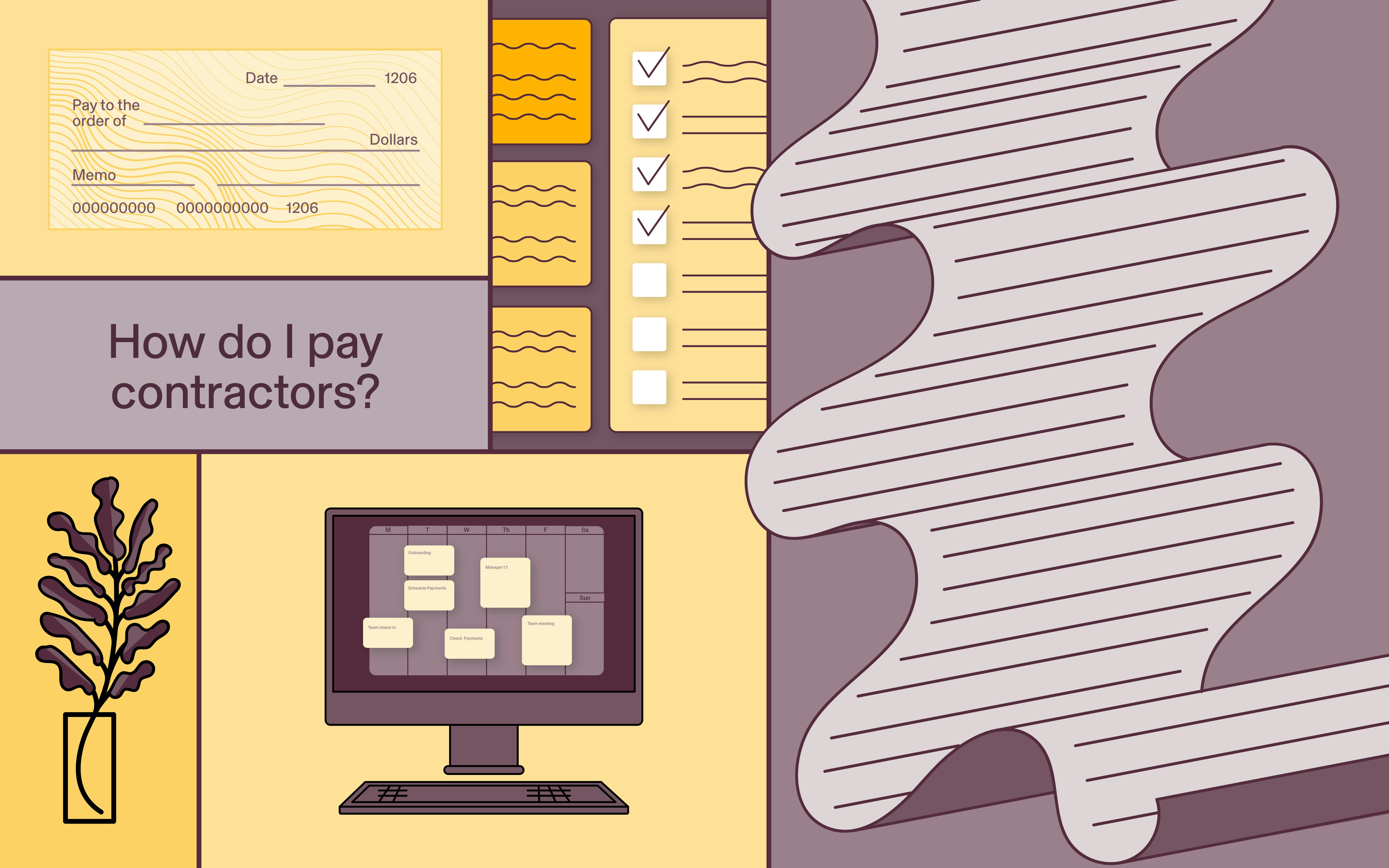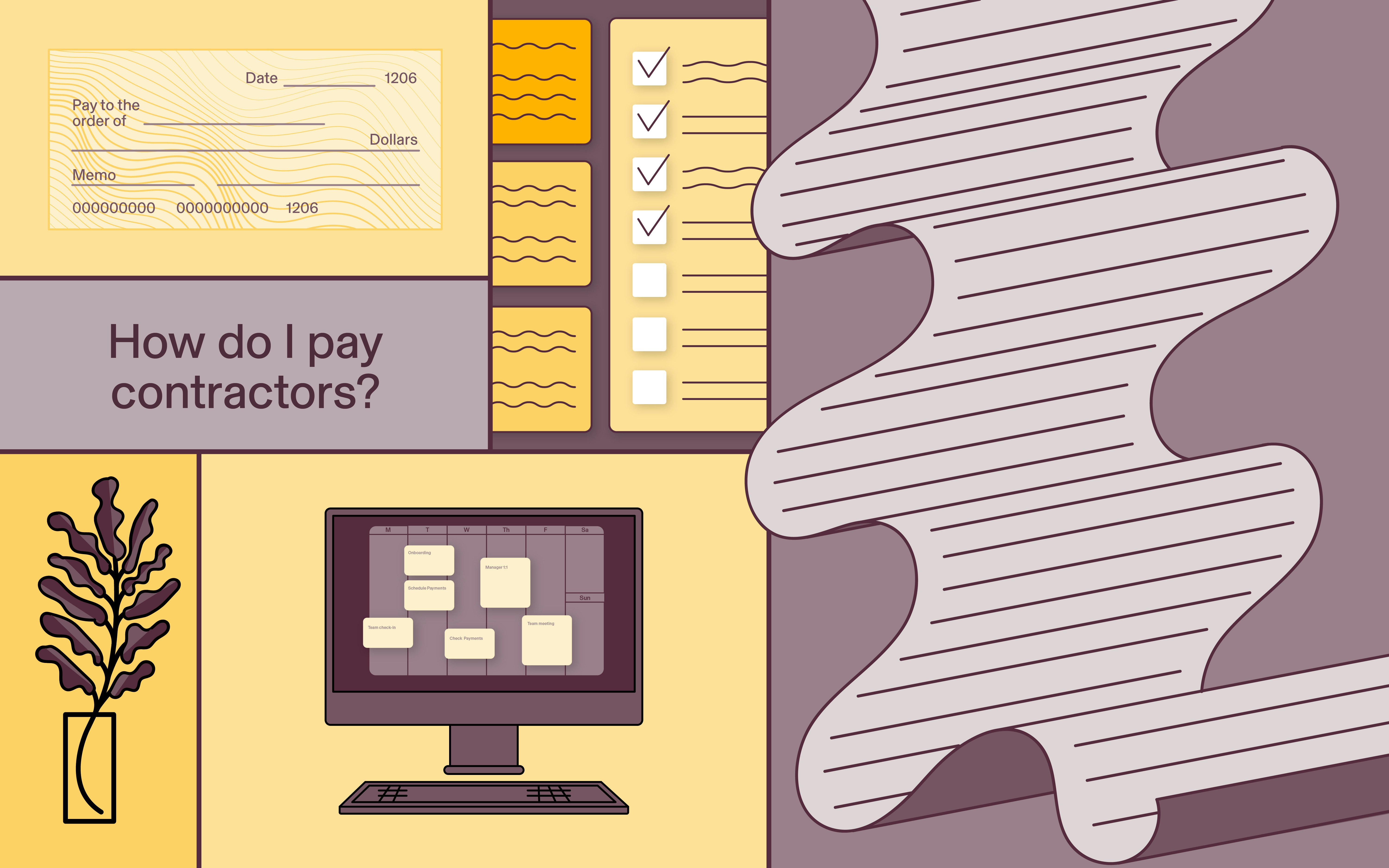How to Pay Independent Contractors (1099)? A Complete Guide

Independent contractors, whether they be sole proprietors, individuals, or companies, are an asset for businesses that require one-off work or have the periodic need to supplement an internal team. Establishing a process to onboard and pay contractors can help you accommodate any type of work, at any scale, exactly when you need it.
Challenges of hiring and paying independent contractors
While independent contractors can play an important role in growing your business, they do come with particular payroll challenges. A casual freelance designer may have no expectations beyond prompt compensation, while an experienced consultant operating as an LLC may have their own invoicing and reporting requirements to consider.
These complexities can lead to increased administrative work for employers, such as customizing contracts, routing internal approvals, logging hours, and running individualized payroll.
How to pay independent contractors in 4 steps
Step 1. Classify your workers
Before running payroll for your 1099 contractors and W-2 employees, you first need to place them into the correct categories. To understand whether a worker qualifies as self-employed or an employee, review the Department of Labor criteria for:
- Finances. Self-employed independent contractors provide their own tools and equipment and pay their own expenses. They will also set deadlines for payment and may require that your business remit payment in a particular currency or through a preferred method.
- Control. Freelancers and other 1099 workers perform a specific set of tasks related to a single project with a clear deliverable. You have the right to accept or reject the final product but cannot decide when and how the work will be done.
- Relationship. Self-employed workers will set out the terms of their performance in an independent contractor agreement signed by the 1099 worker and your company.
Be aware that not all independent contractors will need a 1099. Contractors operating as S corps, for example, should not receive this tax document.
Step 2. Calculate compensation
To understand the total compensation owed to a 1099 contractor, you’ll need to refer to the terms of the independent contractor agreement you signed with your freelancer. Once you’ve confirmed the pay rate, simply multiply that number by the amount of time worked. If your payroll system includes time and attendance tracking, you should have easy access to this information.
Some self-employed freelancers operating as LLCs must send you an invoice for their tax filings and business records. In these cases, you can use your time and attendance tracking software to confirm the amount owed before issuing payment.
1099 contractors are typically not eligible for employee benefits, so no need to withhold FICA or other payroll taxes.
Step 3: Choose your payroll software
While manual payments by wire transfer or business check are viable payment options, particularly for large, one-off payments, modern solutions like automatic payroll software can significantly reduce the administrative burden of processing freelancer payments. This is especially true if your business employs large numbers of independent contractors for specific projects across multiple locations.
Payroll software can also provide peace of mind when it comes to compliance by automating the collection and distribution of important tax forms, storing records, and tracking time and attendance. Automated payroll software also allows you to integrate contractors into your typical payroll run. This ensures that 1099 contractors receive timely compensation and that you don’t accrue late payment penalties on invoices.
While not every contractor may require a loaned computer or access to internal communication platforms, these functions are much easier to have and not use than to integrate after the fact. It’s prudent to make your purchasing decision based on equal parts capability and flexibility.
Step 4: Get your W-9 forms
The IRS requires an independent contractor to provide a W-9 form, which includes the contractor’s contact information and taxpayer identification number.
Many payroll systems require new contractors to complete a W-9 as part of the onboarding process and record the mandatory information. Otherwise, you’ll need to provide a fillable copy to your contractor and receive the completed version before they begin work.
Step 5: Get your contractors set up in your payroll system
Once you've received a contractor’s W-9, you should have what you need to create a user in your payroll system. Most automated payroll systems will allow you to add the contractor’s rate and contract details and offer a time-tracking platform.
At this point, you should also set up user permissions for internal applications like Slack, Outlook, Zendesk, or whatever else your teams rely on to collaborate.
Rippling houses your contractor data alongside your full-time employees' HR and IT data on a single platform, making taxes and other reporting a one-click exercise. Integrating your contractors and employees also means contractors get paid whenever you run payroll.
Step 6: Prepare and send 1099-NEC forms
Businesses working with independent contractors must issue those contractors a 1099-NEC itemizing total annual compensation no later than January 31 of the following year. It’s the functional equivalent of the W-2 you issue to your employees and an important tax document for self-employed contractors.
Generally, you should plan to issue a 1099-NEC to any non-employee who performed services for your business valued at more than $600 in the previous year. This also applies to corporations.
Rippling automatically generates and distributes 1099 forms to eligible contractors and stores them for later reference.
4 Best ways to pay independent contractors
The flexibility that comes with working with 1099 contractors extends to payment methods. Many self-employed workers will accept multiple forms of payment and can accommodate your existing systems.
1. Checks
To pay a contractor by business check, you’ll need to confirm the correct name and, if sending the check by mail, address for each 1099 worker. Be aware that checks not mailed to the contractor must be stored securely until collection.
2. ACH transfers
If you plan to remit payment by bank transfer, you’ll collect the same information from your 1099 contractor as you would from a W-2 employee you plan to pay using direct deposit. You’ll need the contractor's bank account type, bank account number, and routing number.
3. Payroll systems
A payroll system or software solution allows you to integrate your independent contractors into your regular payroll cycle, providing a degree of predictability and automation that one-off solutions lack.
Many payroll systems also include functionalities that save your HR professionals time and simplify compliance, such as automated W-9 requests and 1099 distributions, as well as time tracking tools.
4. Online payment processors
Tools like PayPal and Stripe can simplify payments to international independent contractors without sacrificing the security of a traceable transaction. Contractors working abroad may favor these solutions to control costs associated with converting currencies, while your business benefits from end-to-end visibility and a compliant payment record.
What are the penalties for misclassifying workers?
Both federal and state governments have regulations to protect self-employed workers. Understanding how to classify your workers is important to meeting your obligations to 1099 contractors and protecting your business against penalties.
Worker misclassification can have a range of consequences, from financial penalties to criminal prosecution. At a minimum, you can expect to pay back wages plus FICA withholdings.
Depending on the duration of the misclassification and the size of your business, you may be subject to a per-employee penalty of up to $1000 under the Fair Labor Standards Act (FLSA). The IRS may also assess penalties for failing to file W-2s for misclassified employees.
A payroll software for independent contractors
Payroll software designed primarily for a workforce of W-2 employees can lead to challenges, particularly for evolving businesses that rely on self-employed talent for important projects.
Modern payroll systems understand that your workforce may change as your business develops and provide built-in flexibility to accommodate 1099 contractors. Features like automated 1099 completion and filing, time and attendance tracking, and payroll integration minimize delays and paperwork for you and your self-employed workers.
If your business regularly requires the services of international contractors, automated payroll systems can provide a valuable compliance backstop, automatically generating additional forms and correctly completing tax filings for your company. Some systems, like Rippling, allow you to process international and domestic payments in a single payrun.
How to pay independent contractors FAQs
What is Form 1099?
Form 1099 is a mandatory form that employers must issue once a year to any non-employee who received compensation for services valued at more than $600. Non-employees may be individuals, corporations, partnerships, or estates.
How is Form 1099-NEC completed?
The Form 1099 can be completed either in hard copy or electronically. If you opt to mail paper copies of your completed 1099s to the IRS, be sure to include a Form 1096 cover sheet.
How do I give someone a Form 1099?
The IRS has published a fillable version of the 1099 on its website that you can complete, print, and provide to your contractors. Many automated payroll systems like Rippling will automatically complete 1099s for new contractors as part of their onboarding and handle e-filing with the IRS.
What are the benefits of payroll software?
Payroll software can save your HR professionals valuable time and protect against compliance slip-ups and payroll mistakes. By taking over the administrative work of calculating wages and withholdings and managing important payroll tax findings, payroll software frees teams to focus on substantive tasks like training and recruiting.
This blog is based on information available to Rippling as of July 3rd, 2024.
Disclaimer: Rippling and its affiliates do not provide tax, accounting, or legal advice. This material has been prepared for informational purposes only, and is not intended to provide or be relied on for tax, accounting, or legal advice. You should consult your own tax, accounting, and legal advisors before engaging in any related activities or transactions.










